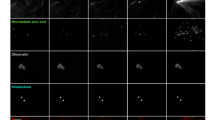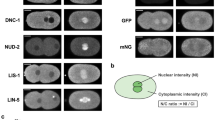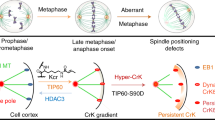Abstract
The activated form of Ran (Ran-GTP) stimulates spindle assembly in Xenopus laevis egg extracts, presumably by releasing spindle assembly factors, such as TPX2 (target protein for Xenopus kinesin-like protein 2) and NuMA (nuclear-mitotic apparatus protein) from the inhibitory binding of importin-α and -β. We report here that Ran-GTP stimulates the interaction between TPX2 and the Xenopus Aurora A kinase, Eg2. This interaction causes TPX2 to stimulate both the phosphorylation and the kinase activity of Eg2 in a microtubule-dependent manner. We show that TPX2 and microtubules promote phosphorylation of Eg2 by preventing phosphatase I (PPI)-induced dephosphorylation. Activation of Eg2 by TPX2 and microtubules is inhibited by importin-α and -β, although this inhibition is overcome by Ran-GTP both in the egg extracts and in vitro with purified proteins. As the phosphorylation of Eg2 stimulated by the Ran-GTP–TPX2 pathway is essential for spindle assembly, we hypothesize that the Ran-GTP gradient established by the condensed chromosomes is translated into the Aurora A kinase gradient on the microtubules to regulate spindle assembly and dynamics.
This is a preview of subscription content, access via your institution
Access options
Subscribe to this journal
Receive 12 print issues and online access
$209.00 per year
only $17.42 per issue
Buy this article
- Purchase on Springer Link
- Instant access to full article PDF
Prices may be subject to local taxes which are calculated during checkout





Similar content being viewed by others
References
Nigg, E. Mitotic kinases as regulators of cell division and its checkpoints. Nature Rev. Mol. Cell Biol. 2, 21–31 (2001).
Andersen, S. Balanced regulation of microtubule dynamics during the cell cycle: a contemporary view. BioEssay 21, 53–60 (1999).
Giet, R. & Prigent, C. Aurora/Ipl1p-related kinases, a new oncogenic family of mitotic serine-threonine kinases. J. Cell Sci. 112, 3591–3601 (1999).
Glover, D., Leibowitz, M.H., McLean, D.A. & Parry, H. Mutations in aurora prevent centrosome separation leading to the formation of monopolar spindles. Cell 81, 95–105 (1995).
Schumacher, J.M., Ashcroft, N., Donovan, P.J. & Golden, A. A highly conserved centrosomal kinase, AIR-1, is required for accurate cell cycle progression and segregation of developmental factors in Caenorhabditis elegans embryos. Development 125, 4391–4402 (1998).
Hannak, E., Kirkham, M., Hyman, A.A. & Oegema, K. Aurora-A kinase is required for centrosome maturation in Caenorhabditis elegans. J. Cell Biol. 155, 1109–1116 (2001).
Roghi, C.R. et al. The Xenopus protein kinase pEg2 associates with the centrosome in a cell cycle-dependent manner, binds to the spindle microtubules and is involved in bipolar mitotic spindle assembly. J. Cell Sci. 111, 557–572 (1998).
Giet, R. & Prigent, C. The Xenopus laevis aurora/Ipl1p-related kinase pEg2 participates in the stability of the bipolar mitotic spindle. Exp. Cell Res. 258, 145–151 (2000).
Walter, A.O., Seghezzi, W., Korver, W., Sheung, J. & Lees, E. The mitotic serine/threonine kinase Aurora2/AIK is regulated by phosphorylation and degradation. Oncogene 19, 4906–4916 (2000).
Geit, R. et al. Drosophila Aurora A kinase is required to localize D-TACC to centrosomes and to regulate astral microtubules. J. Cell Biol. 156, 437–451 (2002).
Katayama, H., Zhou, H., Li, Q., Tatsuka, M. & Sen, S. Interaction and feedback regulation between STK15/BTAK/Aurora-A kinase and protein phosphatase 1 through mitotic cell division cycle. J. Biol. Chem. 276, 46219–46224 (2001).
Francisco, L., Wang, W. & Chan, C.S. Type 1 protein phosphatases acts in opposition to IpL1 protein kinase in regulating yeast chromosome segregation. Mol. Cell. Biol. 14, 4731–4740 (1994).
Andresson, T. & Ruderman, J.V. The kinase Eg2 is a component of the Xenopus oocyte pregesterone-activated signaling pathway. EMBO J. 17, 5627–5637 (1998).
Sassoon, I. et al. Regulation of Saccharomyces cerevisiae kinetochore by the type 1 phosphatase Glc7p. Genes Dev. 13, 545–555 (1999).
Hsu, J. et al. Mitotic phosphorylation of histone H3 is gorverned by Ipl1/aurora kinase and Glc7/PP1 phosphatase in budding yeast and Nematodes. Cell 102, 279–291 (2000).
Biggins, S. et al. The conserved protein kinase Ipl1 regulates microtubule binding to kinetochores in budding yeast. Genes Dev. 13, 532–544 (1999).
Wilde, A. & Zheng, Y. Stimulation of microtubule aster formation and spindle assembly by the small GTPase Ran. Science 284, 1359–1362 (1999).
Ohba, T., Nakamura, M., Nishitani, H. & Nishimoto, T. Self-organization of microtubule asters induced in Xenopus egg extracts by GTP-bound Ran. Science 284, 1356–1358 (1999).
Kalab, P., Pu, R.T. & Dasso, M. The ran GTPase regulates mitotic spindle assembly. Curr Biol 9, 481–484 (1999).
Carazo-Salas, R.E. et al. Generation of GTP-bound Ran by RCC1 is required for chromatin-induced mitotic spindle formation. Nature 400, 178–181 (1999).
Guarguaglini, G. et al. Regulated Ran-binding protein 1 activity is required for organization and function of the mitotic spindle in mammalian cells in vivo. Cell Growth Differ. 11, 455–465 (2000).
Moore, W.J., Zhang, C. & Clarke, P.R. Targeting of RCC1 to chromosomes is required for proper mitotic spindle assembly in human cells. Curr. Biol. 12, 1442–1447 (2002).
Wilde, A. et al. Ran stimulates spindle assembly by changing microtubule dynamics and the balance of motor activities. Nature Cell Biol. 3, 221–227 (2001).
Carazo-Salas, R.E., Gruss, O.J., Mattaj, I.W. & Karsenti, E. RanGTP coordinates the regulation of microtubule nucleation and dynamics during mitotic spindle assembly. Nature Cell Biol. 3, 228–234 (2001).
Wittmann, T., Wilm, M., Karsenti, E. & Vernos, I. TPX2, A novel Xenopus MAP involved in spindle pole organization. J. Cell Biol. 149, 1405–1418 (2000).
Wittmann, T., Boleti, H., Antony, C., Karsenti, E. & Vernos, I. Localization of the kinesin-like protein Xklp2 to spindle poles requires a leucine zipper, a microtubule-associated protein, and dynein. J. Cell Biol. 143, 673–685 (1998).
Merdes, A., Heald, R., Samejima, K., Earnshaw, W. & Cleveland, D. Formation of spindle poles by dynein/dynactin-dependent transport of NuMA. J. Cell Biol. 149, 851–862 (2000).
Merdes, A., Ramyar, K., Vechio, J. & Cleveland, D. A complex of NuMA and cytoplasmic dynein is essential for mitotic spindle assembly. Cell 87, 447–458 (1996).
Gaglio, T., Saredi, A. & Compton, D. NuMA is required for the organization of microtubules into aster-like mitotic arrays. J. Cell Biol. 131, 693–708 (1995).
Gruss, O.J. et al. Ran induces spindle assembly by reversing the inhibitory effect of importin α on TPX2 activity. Cell 104, 83–92 (2001).
Wiese, C. et al. Role of Importin-β in coupling Ran to downstream targets in microtubule assembly. Science 291, 653–656 (2001).
Nachury, V.M. et al. Importin β is a mitotic target of the small GTPase Ran in spindle assembly. Cell 104, 95–106 (2001).
Murray, A.W. Cell cycle extracts. Methods Cell Biol. 36, 581–605 (1991).
Kufer, T.A. et al. Human TPX2 is required for targeting Aurora-A kinase to the spindle. J. Cell Biol. 158, 625–637 (2002).
Giet, R., Uzbekov, N., cubizolles, F., Le Guellec, K. & Prigent, C. The Xenopus laevis aurora-related protein kinase pEg2 associates with and phosphorylates the kinesin-related protein XlEg5. J. Biol. Chem. 274, 15005–15013 (1999).
Gruss, O.J. et al. Chromosome-induced microtubule assembly mediated by TPX2 is required for spindle formation in HeLa cells. Nature Cell Biol. 4, 871–879 (2002).
Zhou, H. et al. Tumour amplified kinase STK15/BTAK induces centrosome amplification, aneuploidy and transformation. Nature Genet. 20, 183–193 (1998).
Sen, S., Zhou, H. & White, R.A. A putative serine/threonine kinase encoding gene BTAK on chromosome 20q13 is amplified and overexpressed in human breast cancer cell lines. Oncogene 14, 2195–2200 (1997).
Bischoff, J. & Plowman, G.D. The Aurora/Ipl1p kinase family: regulators of chromosome segregation and cytokinesis. Trends Cell Biol. 9, 454–459 (1999).
Acknowledgements
We thank S. Lizarraga for help with egg extracts, M. Inskeep for technical support, D. Golick for His-tagged RanQ69L, E. Lees for the anti-Eg2 antibody, M. Guo and the members of the Zheng lab for comments. Supported by the Howard Hughes Medical Institute (Y.Z.), by CNRS, ARC, and LNCC of France (C.P.) and by National Institutes of Health grant HD23696 (J.R.).
Author information
Authors and Affiliations
Corresponding author
Ethics declarations
Competing interests
The authors declare no competing financial interests.
Rights and permissions
About this article
Cite this article
Tsai, MY., Wiese, C., Cao, K. et al. A Ran signalling pathway mediated by the mitotic kinase Aurora A in spindle assembly. Nat Cell Biol 5, 242–248 (2003). https://doi.org/10.1038/ncb936
Received:
Revised:
Accepted:
Published:
Issue Date:
DOI: https://doi.org/10.1038/ncb936
This article is cited by
-
Aurora kinase A inhibition induces synthetic lethality in SMAD4-deficient colorectal cancer cells via spindle assembly checkpoint activation
Oncogene (2022)
-
Integrative network analysis of early-stage lung adenocarcinoma identifies aurora kinase inhibition as interceptor of invasion and progression
Nature Communications (2022)
-
Bora phosphorylation substitutes in trans for T-loop phosphorylation in Aurora A to promote mitotic entry
Nature Communications (2021)
-
Structural mechanism of synergistic activation of Aurora kinase B/C by phosphorylated INCENP
Nature Communications (2019)
-
Taxane-mediated radiosensitization derives from chromosomal missegregation on tripolar mitotic spindles orchestrated by AURKA and TPX2
Oncogene (2018)



